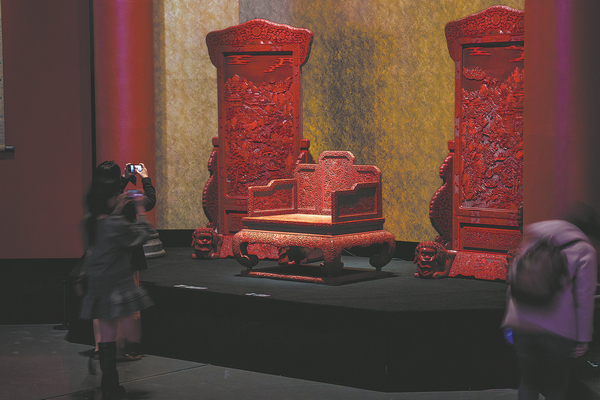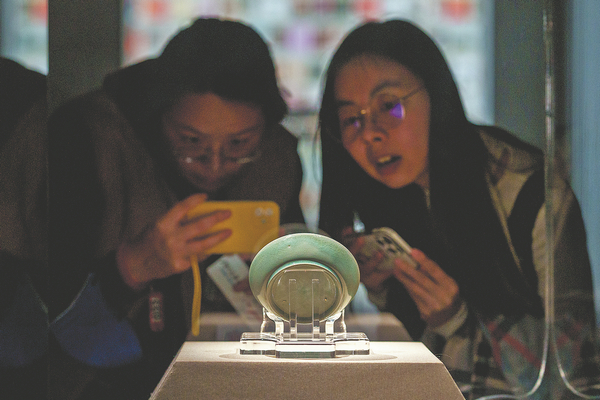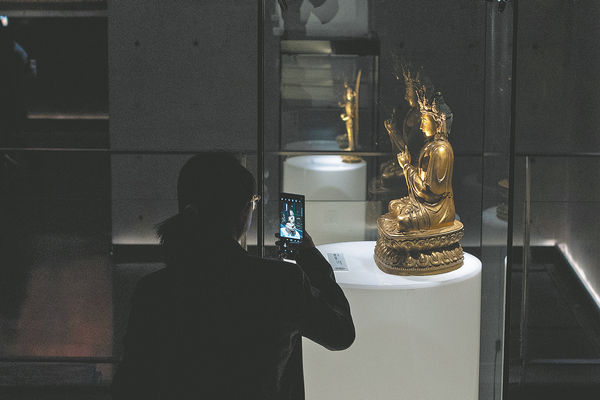

Fourteen years after the founding of their private Long Museum in Shanghai, Liu Yiqian and his wife Wang Wei decided to present some pieces from their most valued collection to the public.
The exhibition Panorama: Timeless Imprints of Civilization features a selection of more than 200 artifacts, including oracle bones and bronze vessels from the Shang Dynasty (c.16th-11th century BC), ceramic wares from landmark periods, imperial furniture, and more others that span more than 3,000 years of Chinese history. Some objects have made news headlines in past decades for their exceptionally high auction prices.
Such exhibits include a doucai (a porcelain enameling technique meaning "contrasting colors") chicken cup from the reign of Chenghua (1465-87) in the Ming Dynasty (1368-1644), which Liu bought at an auction in 2014 for $36 million. Some have not been shown to the public for 10 years, while some are making their public debut, such as the Archaic Bronze Xijia Plate dating back to the Western Zhou Dynasty (c.11th century-771 BC) and a Celadon-glazed Ru Kiln (one of the famed Song Dynasty kilns located in Henan province) Brush Washer from the Northern Song Dynasty (960-1127).

"I don't want to talk about the cost or value of my collection but rather the continued heritage of Chinese civilization through the past three millennia. Collecting is a personal journey but civilization belongs to everyone," Liu said at the opening on March 21.The exhibition will conclude on June 29.
"My husband and I began our collection over 30 years ago," says Wang, who also serves as the director of the Long Museum. "It has been 14 years since we founded Long Museum. Starting from traditional Chinese art, we have gradually built a systematic collection, from classical to modern and contemporary Chinese art, as well as modern and contemporary world art.
"Every piece in our collection has been carefully evaluated and selected based on its artistic and historical value," she continues. "Especially for ancient Chinese art, we place a particular emphasis on lineage and provenance, as these works are not merely cultural treasures but also witnesses to history. Over the past three decades, these collections have woven together a string of unique stories that continue to unfold."

Nicolas Chow, chairman of Sotheby's Asia and worldwide head of Asian art, writes in his preface for Liu's collection of Chinese ceramics, "Together with the classical and modern paintings and calligraphies that he has gathered, they form perhaps the most significant collection of Chinese art assembled by a single individual in modern times".
This is the first time for the Long Museum to display so many assorted antiques, such as bones, bronze, jade furniture and ceramics, in an exhibition. As curator of the exhibition, Liu says that he put more effort into this exhibition than any other.
"I wanted to find the best way to showcase these ancient objects in a modern structure made of armored concrete and create a dialogue between art and architecture that transcends time and space," he says.
The main exhibition hall of the Long Museum on the West Bund, one of its three locations, has an impressive 8-meter-high ceiling and a dark interior with lights focusing on each artifact.
Liu especially wants to highlight a half-preserved jade memorial seal fragment of Empress Wen during the reign of Emperor Hongxi (1424-25) in the Ming Dynasty.
"As far as I know, this is the only surviving jade seal from the court of Ming, and it has traces of being burned in a fire," Liu says.
While seals have long been an emblem of imperial power in China, they also tell of the cruelty and sadness behind the change in power and transition of dynasties, Liu adds.
Contact the writer at zhangkun@chinadaily.com.cn